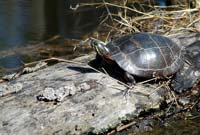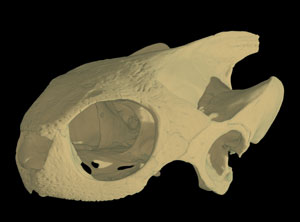Chrysemys picta, the painted turtle, is a member of Emydidae within Cryptodira. There are four subspecies of C. picta: the eastern (C. p. picta), western (C. p. bellii), southern (C. p. dorsalis), and central (C. p. marginata) painted turtles, each of which is endemic to a particular region of the extensive range of this species, which covers most of the United States and includes parts of Mexico and Canada (Ernst and Barbour, 1989; Bonin et al., 2006). Emydidae contains the most species of any turtle group, and has an evolutionary record stretching back 80 million years (Ernst and Barbour, 1989; Bonin et al., 2006). Emydidae is closely related to the Old World pond turtles and tortoises (Geoemydidae and Testudinidae, respectively), but the relationship of these three close relatives to other turtles is unclear (e.g., Gaffney and Meylan, 1988; Joyce, in press).
Chrysemys picta is  a small turtle, reaching 25 cm in length (Ernst and Barbour, 1989; Bonin et al., 2006). The skull is of moderate size with respect to the body and is somewhat emarginated. The carapace is oval and flattened, and the plastron is well developed. Chrysemys picta is olive to black dorsally with yellow or red borders on seams and red markings on the marginal scutes, and a medial red or yellow stripe is variably present. The plastron is yellow and may exhibit a dark blotch. The neck, legs, and tail are striped with red and yellow, while the head exhibits complex yellow markings that include large spots behind the eyes. Color patterns vary among subspecies (Ernst and Barbour, 1989; Bonin et al., 2006).
a small turtle, reaching 25 cm in length (Ernst and Barbour, 1989; Bonin et al., 2006). The skull is of moderate size with respect to the body and is somewhat emarginated. The carapace is oval and flattened, and the plastron is well developed. Chrysemys picta is olive to black dorsally with yellow or red borders on seams and red markings on the marginal scutes, and a medial red or yellow stripe is variably present. The plastron is yellow and may exhibit a dark blotch. The neck, legs, and tail are striped with red and yellow, while the head exhibits complex yellow markings that include large spots behind the eyes. Color patterns vary among subspecies (Ernst and Barbour, 1989; Bonin et al., 2006).
As described above, Chrysemys picta ranges across all of North America, from southern Canada to northern Mexico. It inhabits slow-moving, shallow water, and prefers locations with soft bottoms, plenty of vegetation, and suitable basking sites. It may enter brackish water along the Atlantic coast (Ernst and Barbour, 1989; Bonin et al., 2006). Young C. picta are carnivorous, but become omnivorous as adults. Painted turtles will feed opportunistically on almost any available food item. Females lay two to three clutches per year, each containing from two to 20 eggs, but do not reproduce every year (Ernst and Barbour, 1989; Bonin et al., 2006).

Literature
Bickham, J.W. and J.L. Carr. 1983. Taxonomy and phylogeny of the higher categories of cryptodiran turtles based on a cladistic analysis of chromosomal data. Copeia 1983:918-932.
Bonin, F., Devaux, B., and A. Dupré. 2006. Turtles of the World. Translated by P.C.H. Pritchard. Johns Hopkins University Press, Baltimore MD.
Congdon, J.D., Nagle, R.D., Kinney, O.M. and R.C.V. Sels. 2003. Testing hypotheses of aging in long-lived painted turtles (Chrysemys picta). Experimental Gerontology 38:765-772.
Ernst, C.H. and R.W. Barbour. 1989. Turtles of the World. Smithsonian Institution Press, Washington DC.
Ferri, V. 2002. Turtles and Tortoises. Firefly Books, Willowdale, ON.
Gaffney, E.S. 1972. An illustrated glossary of turtle skull nomenclature. American Museum Novitates 2486:1-33.
Gaffney, E.S. 1979. Comparative cranial morphology of recent and fossil turtles. Bulletin of the American Museum of Natural History 164:1-376.
Gaffney, E.S. and P.A. Meylan. 1988. A phylogeny of turtles. In: Benton, M.J., editor. The Phylogeny and Classification of the Tetrapods, Volume 1: Amphibians, Reptiles, Birds. Clarendon Press, Oxford, pp. 157-219.
Jamniczky H.A. In press. Turtle carotid circulation: a character analysis case study. Biological Journal of the Linnean Society.
Jamniczky, H.A. and A.P. Russell. 2007. Reappraisal of patterns of nonmarine cryptodiran turtle carotid circulation: evidence from osteological correlates and soft tissues. Journal of Morphology 268:571-587.
Joyce, W.G. 2007. Phylogenetic relationships of Mesozoic turtles. Bulletin of the Peabody Museum of Natural History 48:3-102.
McDowell, S.B. 1964. Partition of the genus Clemmys and related problems in the taxonomy of aquatic Testudinidae. Proceedings of the Zoological Society of London Series B 143:239-279.
Orenstein, R. 2001. Turtles, Tortoises, and Terrapins: Survivors in Armor. Firefly Books, Buffalo, NY.
Packard, G.C. and M.J. Packard 2006. The relationship between gut contents and supercooling capacity in hatchling painted turtles (Chrysemys picta). Comparative Biochemistry and Physiology A – Molecular and Integrative Physiology 144:98-104.
Pritchard, P.C.H. 1979. Encyclopedia of Turtles. TFH Publishing, Neptune FL.
Rivera, G., Rivera, A.R.V, Dougherty, E.E. and R.W. Blob. 2006. Aquatic turning performance of painted turtles (Chrysemys picta) and functional consequences of a rigid body design. Journal of Experimental Biology 209:4203-4213.
Rowe, J.W., Clark, D.L., Ryan, C. and J.K. Tucker. 2006. Effect of substrate color on pigmentation in midland painted turtles (Chrysemys picta marginata) and red-eared slider turtles (Trachemys scripta elegans). Journal of Herpetology 40:358-364.
Shaffer, H.B., Meylan, P., and M.L. McKnight. 1997. Tests of turtle phylogeny: molecular, morphological, and paleontological approaches. Systematic Biology 46:235-268.
Starkey, D.E., Shaffer, H.B., Burke, R.L., Forstner, M.R.J., Iverson, J.B., Janzen, F.J., Rhodin, A.G.J., and G.R. Ultsch. 2003. Molecular systematics, phylogeography, and the effects of Pleistocene glaciation in the painted turtle (Chrysemys picta) complex. Evolution 57:119-128.
Links
Chrysemys picta page on Animal Diversity Web.
C. picta page on the Illinois Natural History Survey










